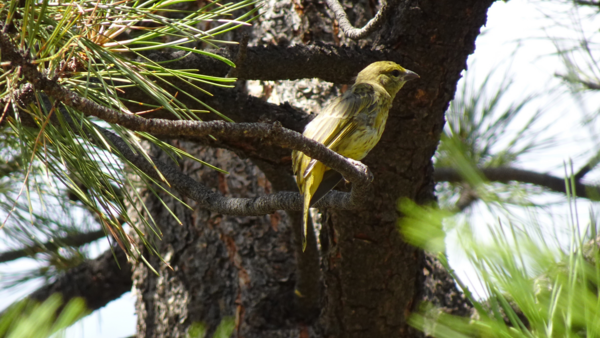Birds: The gateway to exploring nature
“Wherever there are birds, there is hope.” — Mehmet Murat Ildan
By DR. CAMERON BARROWS
Birds can often be a “gateway” for exploring nature. Wherever you are, as long as you are outside, there are birds. Visit Antarctica, you could see up to 62 species of birds. No lizards, few if any insects, but there are birds. Across North America you might find 900 species of birds, but go to South America and you could see 3,500 species. Worldwide there are close to 10,000 species of birds. Compared to lizards, at about 7,000 species worldwide, birds are considerably more speciose, although comparing birds to all reptiles (10,700 species) might be a fairer evaluation.
However, there are no lizards in the Arctic, Antarctic, or more than a hundred miles or so into Canada or the northern regions of Europe and Asia. Snakes make it a bit further north than lizards, but nowhere near as far north as do birds (and mammals). The difference for birds being able to exploit those far northern regions is their ability to generate their own heat (being endothermic or “warm blooded”) versus needing the sun’s heat to raise their temperature above freezing (reptiles, who are ectothermic). Interestingly, birds and lizards tend to have similar preferred body temperatures, so the warm blooded-cold blooded distinction is not accurate, it’s just that birds need to consume lots of calories to stoke their internal furnace, whereas lizards just move in and out of the sun’s rays.
Roughly 66 million years ago an asteroid slammed into the earth. The asteroid was believed to be between 10 and 15 kilometers wide and created the Chicxulub crater, 150 kilometers wide, off the edge of the Yucatan Peninsula in what is now Mexico. There were huge tidal waves that swept across the continents and the pulverized rock debris that was sent up into the atmosphere caused the sky to be dark for years. Dinosaurs, who were endothermic and needed growing plants (and the dinosaurs that ate those growing plants) to eat and stoke their internal furnaces, went extinct in that geologic moment. While many species also went extinct, generally reptiles and fossorial mammals were able to survive, weathering the apocalypse in burrows and crevices and not needing to eat much but carrion and seeds for months or even years. However, there was one group of dinosaurs that also survived. Today we call them birds. Just how birds survived is not known, but my guess is that their mobility allowed some of them to find little pockets of food to keep alive long enough until the sun once again began to shine through the haze and plants again could grow.
While birds now exist in every nook and cranny of our planet, the hottest and driest deserts, portions of the Colorado and Mojave Deserts, have not been a biome that many bird species have called home. This is the land of reptiles. To be clear, some birds thrive in deserts, but compared to the tropics, their numbers are relatively low. In our hottest and driest deserts, horned larks, black-throated sparrows, rock and canyon wrens, and LeConte’s thrashers still thrive, but are nowhere abundant. Add some moisture and taller vegetation structure (Joshua trees, palo verde and ironwood trees, honey mesquite, agaves, and tall cacti) and many more bird species join the community. Here we can find Scott’s orioles, phainopepla, cactus wrens, verdins, Costa’s hummingbirds, Say’s phoebes, ash-throated flycatchers, house finches, Crissal thrashers, ladder-backed woodpeckers, loggerhead shrikes, common ravens, roadrunners, mourning doves, and red-tailed hawks. Travel to the land of the saguaro cacti, the true Sonoran Desert, and an additional assortment of birds can be found. Harris’s hawks, Gila woodpeckers and gilded flickers, elf owls, ferruginous pygmy owls, and curve-billed and Bendire’s thrashers. This abundance of avian life brings home the tragedy of wildfires and other sources of habitat loss in the desert. Burn or plow away that structure, or if it gets still hotter and drier so that vegetation structure can no longer be supported, and all that feathered diversity disappears.
That desert feathered diversity is impressive, but pales in comparison to what assaults your senses in the tropical biomes. The cacophony of bird sounds and colors in say, Costa Rica or the Amazon Basin is overwhelming. It can take days and weeks to separate that cacophony into individual species, which is both exhilarating and intensely frustrating. The fewer desert birds can allow naturalists to hone their skills at both visual and auditory bird species identification. Unlike lizard identifications, which are entirely visual, bird identification is best done with a combination of both visual and auditory cues. As naturalists become increasingly adept at identifying birds by their call notes and songs, your senses are opened up to a much broader spectrum of the nature around us.
I wanted to challenge your identification skills with the attached picture of a bird I saw in an open ponderosa pine – gamble’s oak forest near Flagstaff, Arizona this summer. It is a juvenile bird and that can make identifications especially difficult. No one on iNaturalist has been able to confirm what species it is, although I am pretty sure I have it right. So please do not look on iNaturalist to see what I think it is. It’s about the size of a robin or a grosbeak (but is not either of those). Pay attention to its bill shape and color, and remember it is a juvenile so the plumage color will be of limited help. Let’s see who gets it right!
